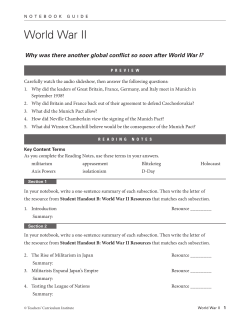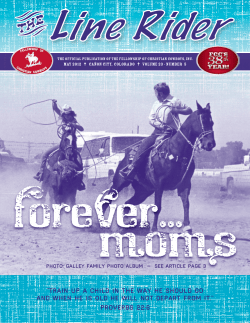
— Grade 3: Bilingual (Lorena Sanchez) LESSON PLANNING TEMPLATE
LESSON PLANNING TEMPLATE — Grade 3: Bilingual (Lorena Sanchez) Lesson Title: Text Type/Writing Genre: Grade Level: Upstanders, Not Bystanders Problem Solution Letter (blending informative/opinion) Grade 3: Bilingual Writing Prompt (developed or adapted for your grade level/student populations): Write a letter to a Ramon, Clever, or Dreamer from “It Doesn't Have to Be This Way;” about the hard decision he/she faced and about the choice he/she made. Tell the character what you thought of his/her decision and what his/her actions taught you about being an ally. If you disagreed with his/her actions, offer suggestions for what he/she could have done instead to be an ally. Learning Objective(s): Students will identify what an ally is (as a literary character and as a member of a family and community). Students will identify hard decisions characters needed to make, analyze the consequences of those choices, and reflect on what the character teaches them about being an ally/upstander. California CCSS for ELA Addressed: California Content Standards addressed: ELA 3 W 1, 3 ELA 3 SL 3, 6 ELA 3 L 1, 6 N/A Although many of the Writing standards will be addressed, I will focus on Writing Standard #3: “Write narratives to develop real or imagined experiences or events using effective technique, descriptive details, and clear event sequences.” Rationale: I chose this standard because I want students to be able to effectively communicate through writing not only events which have unfolded before, but also to describe events which may occur to them, and thus give them a voice in writing. Furthermore, I will focus on writing personal and formal letters because I feel that the art of the written letter is one which must not disappear in the face of technological advances which surround my students. Even if ELD Standards addressed: Interaction A.1, 2, 3 Productive C.11 I will focus on Interaction A 3: Offering and supporting opinions and negotiating with others in communicative exchanges. Rationale: I chose this focus because students need to be able to write persuasively in a variety of situations, from letters to Santa to college applications to cover letters in resumes. I think it is important for students to be able to persuade through their writing and let their opinions and their voices be heard in a letter or other text. they only utilize email, they will benefit from knowing how to properly address, greet, and close a letter. Additionally, it is a skill which may help students gain employment, communicate effectively, and become better writers. Academic Language Focus: Language of persuasion and opinion Stating clearly the author’s opinion Offering solutions to a problem Method(s) for Formative Assessment or Checking for Understanding Along the Way: Students summarize reading throughout the book, then pair share ideas, discussing who is an ally, who is a victim, and who is making right/wrong choices. Plans for writing assessment and feedback: Students will review parts of a letter; discuss how to write letter paragraphs with a topic, details, and conclusion; and write a letter to one of the characters, stating their opinion about that character’s actions. Plans for Instructional Sequence (include support for steps deemed crucial — reading, writing, language, academic talk, revision): Building to the lesson/Drawing on prior instruction: 1. Students have been taught parts of a letter by writing weekly letters to the Student of the Week. 2. Students have been taught to write the paragraph structure that includes a hook, topic sentence, details, and a conclusion. Additionally, editing and revising have been introduced as a system of peer review, individual review, and teacher critique. 3. Students have participated monthly in assemblies where bullying, being an ally, and strategies to prevent becoming a victim or a bystander are the focus. 4. Class discussions about individual responsibility, making good choices, and helping others make the right choice for a situation are part of our class meetings. 5. Fluency practice in Spanish and English. 6. Students participate in English Language Development classes daily for an hour. 7. Daily writing in the form of Word of the Day, guided writing, modeled writing, and independent writing. Writing the letter to the character: 1. Read both the English and Spanish versions of “It Doesn’t Have to be this Way” with students, taking time to discuss how each character makes choices which determine their actions as the plot develops. 2. After reading the story, discuss how Dreamer, Clever, and Ramon all made choices which led to Dreamer being shot. Then, talk about how Dreamer and Ramon’s uncle helped him when he made the choice to get out of the gang. Support students to talk about times when someone they know has helped them to make a better choice. Then, ask them to discuss with a partner what they think about each of the character’s choices. Did Clever make a good choice by being in a gang? Did Dreamer make a good choice by talking Ramon out of being in the gang? How did Ramon’s choice to be in a gang, and later not be in a gang, affect him, his family, and his future? 3. Review with students the five parts of a letter, using body movements: The heading (pat head) The salutation or greeting (make a salute) The body (wiggle your body) The closing (close arms in scissors movement) And the signature (use foot to “sign” your name on the floor) 4. On the board, put up a sample of a letter that includes all five parts, and have random students come up and identify the five parts of the letter. 5. Tell students that they are to choose one of the characters in the story, and that they will write a letter to that character. In the letter, students are to talk to the character about their choices and help them make better choices, if possible, or tell them how their choices are the correct ones. Remind students that they are to write to the characters as though they are kids from the neighborhood, someone they know, so that the tone of the letter is informal. However, remind students that they are being allies or upstanders by giving the character help in making better choices. Have them discuss with a neighbor/partner how they could help each of the characters and then give them time to write the letter independently. 6. Once students have finished their letters, have them get in groups according to the person they wrote to, and share their letters to get more ideas from other students. 7. Students may edit/revise their letters after the sharing and then then turn in the letters. Teacher Observations Upon Completion of Lesson: The letter writing went very well; so well that I expanded the lesson sequence with more lessons to tie in with the upcoming civil rights anniversaries, the Martin Luther King, Jr. holiday, etc. To connect their learning about allies in literature to learning about allies in history, especially those who were civil rights upstanders, we first read several books about Ruby Bridges. We gathered examples of how Ruby was an upstander and who the allies were for her. We collected phrases and words we could use in an informational report about her as an upstander. Students chose their own historical upstander. Some chose Ruby Bridges and others chose Cesar Chavez, Martin Luther King, Jr., Abraham Lincoln, and Barack Obama. Students researched basic biographical information, the upstanding act(s) their upstander is known for, and why their upstander inspires people. Students wrote their informational report in English and Spanish, working with me on phrases and language that is correct for both languages (not writing a translation). After they completed the written report, they created a PowerPoint (PPT) report about their upstander. They searched for images for their slides and selected essential information for each slide. Students presented their reports and posted all writing on our class Wiki letters, informational reports, and PPT reports. Important Instructional Strategies: Rich discussion with partners and whole class about bullying, bystanders, upstanders (allies), and victims/bullies Multiple modality lessons which include songs, drawings, chants, repetition of text, in order for students to gain rich academic language Posting of student work as well as modeled writing around the room for students to refer to Text-Based Resources Needed: Texts to increase content and language knowledge: Essential for my lesson: Rodrigues, L.J. It Doesn't Have to Be This Way/ No Tiene Que Ser Asi: A Barrio Story/Una Historia del Barrio. New York, NY: Children’s Book Press, 2004. Additional support: Lester, H. Hooway for Wodney Wat. Torrance, CA: Sandpiper, 2002. Nickel, J. The Ant Bully. New York, NY: Scholastic Press, 1999. Polacco, P. Thank You, Mr Falkner. New York, NY: Babushka, Inc., 1998. Yashima, T. Crow Boy/Niño Cuervo. London: UK, Puffin, 1976 Additional Materials Needed: For extension lessons: books, digital texts, and web resources about historical allies/upstanders such as Ruby Bridges, Martin Luther King, Jr., and Cesar Chavez. Elements That May Need Modification: More practice with writing informative text Adding an oral presentation Suggested Instructional Modification: Students will be writing an informative piece on an upstander of their choosing, but they may need to write collaboratively about other characters as upstanders to practice the language of opinion and information in the context of ally/upstander. Students will read their letters to one another, suggest revising/editing/modifications. Digital Support or Digital Extensions: After this lesson, the students wrote informational reports about an upstander which will convert to PPT or videos to share via the class Wiki. Adapted from the Lesson Template developed by the Northern California Writing Project for Cross-disciplinary inquiry into the CCSS.
© Copyright 2025





















